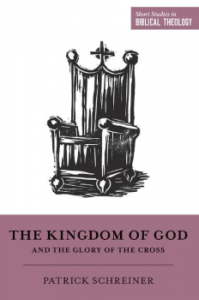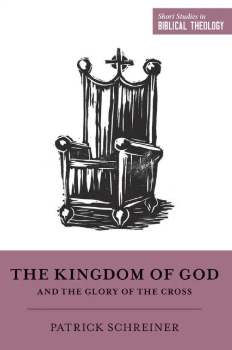Schreiner, Patrick. The Kingdom of God and the Glory of the Cross. Short Studies in Biblical Theology. Wheaton, IL: Crossway, 2018, pp. 159, $14.99, paperback.
Patrick Schreiner is assistant professor of New Testament at Western Seminary in Portland, Oregon. In addition to The Kingdom of God and the Glory of the Cross, Schreiner has published The Body of Jesus and other articles and essays. The Kingdom of God and the Glory of the Cross is part of Crossway Publisher’s Short Studies in Biblical Theology series. According to the series editors, “The purpose of Short Studies in Biblical Theology is to connect the resurgence of biblical theology at the academic level with everyday believers” (p. 11). Each volume is written with readers who have no theological training in mind.
Schreiner defines the kingdom of God as “the King’s power over the King’s people in the King’s place,” a definition similar to those put forth by other evangelical scholars. While recognizing all three elements are essential, Schreiner expresses concern that evangelicals often focus on the King’s power or rule (p. 15). The neglect of people and place has often led to the abstraction of the kingdom out of its narrative framework. While never ignoring the King’s rule, Schreiner emphasizes the people and place of the kingdom throughout his book. By defining “the kingdom of God” as the King’s power, people, and place, Schreiner is able to argue that the theme of kingdom is present in Scripture “from the beginning to the end” (24).
Schreiner follows a Hebrew arrangement of the Old Testament and offers summary statements seeking to encapsulate each division’s (Law, Prophets, and Writings) message concerning God’s kingdom (p. 24). Schreiner summarizes the Law’s teaching on the kingdom as “reviving hope in the kingdom.” Contrary to what is often thought, the theme of kingdom did not originate with Jesus in the Gospels or even with the rise of the Israelite monarchy. Instead, as Schreiner argues, the theme of kingdom originates in the initial chapters of Genesis. God created (power), Adam and Eve (people), to be his king and queen over creation (place). This kingdom plan quickly becomes corrupted, however, and thus hope in this kingdom must be revived. This revival of hope in the kingdom comes from God’s promises to Abraham (Gen 12:1–3), his creation of a kingdom of priests (Exod 19:6), and that kingdom’s (often tenuous) journey to the Promised Land. Schreiner summarizes the Prophets as “foreshadowing the kingdom.” Although God brings (power) Israel (people) into the Promised Land (place), this is not an inauguration of the kingdom but a foreshadowing of the true kingdom. Furthermore, the prophets place faith in a coming Davidic ruler who will realize the kingdom. Schreiner summarizes the Writings as “life in the kingdom.” These books give a poetic picture of life in the kingdom” (67). “Life in the kingdom” is established by acquiring wisdom, fearing the Lord, and suffering righteously. The Writings conclude by anticipating a return from exile led by the messianic king.
Turning to the New Testament, Schreiner argues that the four Gospels each focus on a different element of the kingdom. Matthew focuses on the King’s place; Mark focuses on the King’s power; Luke focuses on the King’s people; John focuses on life in the kingdom. Acts is framed by references to the kingdom (Acts 1:3–6; 28:23, 31) and shows the spread of the kingdom community from Jerusalem to Judea, Samaria, and to the ends of the earth (Rome). Although the kingdom terminology is not prevalent in the New Testament Epistles, the idea forms the narrative framework underlying them. For instance, Paul recognizes Christ as king (Col 1:15–20; Phil 2:6–11), describes how the covenant community enters the kingdom, encourages readers to share in the rule of the king, and looks forward to the rule of the king. Schreiner summarizes Revelation as achieving the kingdom’s goal. The opposition to the king’s power is defeated. The people of the kingdom are gathered to the king, and the place of the kingdom is revealed. Schreiner concludes by emphasizing the importance of the cross for the kingdom. He concludes by presenting two stories (Passover and the convicts crucified with Jesus) emphasizing the importance of the cross.
Schreiner makes a compelling argument for the centrality of kingdom within every part of Scripture. Without a doubt, his presentation of God’s kingdom as consisting of power, people, and place will aid readers in seeing the pervasiveness of this important topic in Scripture. Additionally, his stress on the narrative foundation of the kingdom theme will help readers who tend to abstract much of the Bible’s message into a sovereignty lesson.
There were a couple of things which I felt could have been potentially misleading to the intended audience. First, although I am not an expert in the Gospels, Schreiner’s depiction of each Synoptic Gospel as emphasizing a particular aspect of his kingdom definition felt somewhat contrived to me. To his credit, Schreiner does acknowledge that each Gospel contains all three aspects and that his presentation was one of emphasis, but since this is the case, I think it would have been more effective to show how each Gospel contained a full expression of the kingdom as Schreiner defined it.
Second, given that this series is directed towards an audience with no theological training, I wonder how necessary it was for Schreiner to emphasize the importance of people and place over power. Schreiner certainly does not ignore the power/rule aspect of the kingdom, but he does seem to favor people and place on multiple occasions. While I would agree with his general assessment that power is often emphasized at the expense of people and place (especially in some evangelical circles), I am not certain that addressing this imbalance in a book directed to a non-theologically trained audience will prove to be helpful. On a related note, in a few places, Schreiner seems to assume more theological background from his audience than he should. One instance I have in mind is when he refers to Adam and Eve as “priest” (38). Schreiner (rightly) shows that Adam and Eve are depicted as royal figures (30–31) but does not argue for their “priestly” role. He does mention that they were to “work” and “keep” the garden, which is an important indicator of their priestly role, but he does not make this connection explicit.
Despite these critiques, there is no reason to deny that Schreiner has written a tremendously helpful guide to the theme of kingdom within the Bible for the theological non-specialist. Average church members and even many theologically trained pastors (especially those who have abstracted this theme) would benefit from this study.
Casey K. Croy
The Southern Baptist Theological Seminary





